AGING AND SUN-DAMAGED SKIN
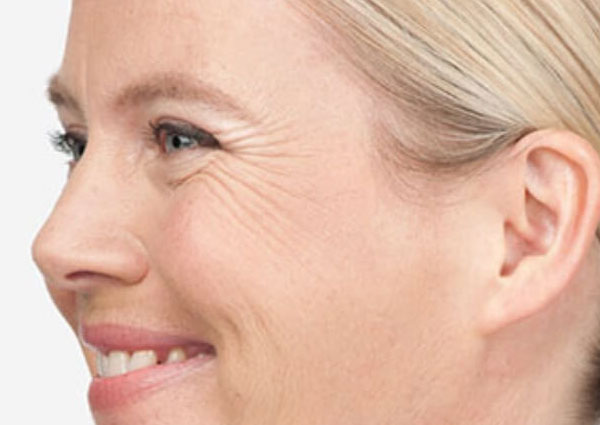

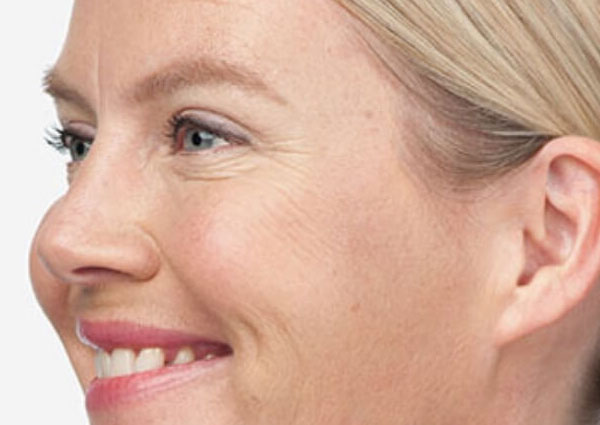
Dr. Angela Moore and Arlington Center for Dermatology offer everything from prevention to reversal of aging and/or sun-damaged skin. First we will evaluate what are your skin concerns and goals. Then we will discuss options for improving your skin health and rejuvenation with treatment and product methods such as light and laser treatments, chemical peels, skin-lifting treatments, BOTOX Cosmetic®, and injectable fillers. We will also customize a skin care program made up of professional and/or prescription products.
WHAT CAUSES AGING SKIN?
Sun damage is the most profound factor in development of aging of the skin. The most important other cause in facial aging besides sun damage is cigarette smoking. Another possible contributing factor in women is loss of estrogen. Finally, genetics, nutrition and other environmental factors probably play important roles which are yet to be elucidated.
The best approach for prevention of skin aging are the practice of good sun protection and avoidance of cigarette smoking. A recent study of identical twins revealed that factors such as sun exposure, cigarette smoking, stress and alcohol ingestion had a dramatic negative effect on aging changes that were independent of heredity. Certain topical preparations have been shown to reverse some signs of photo-aging. It has been assumed that these anti-aging preparations also can prevent skin aging, although no real studies have been performed which establish a regimen for this purpose. It is possible that antioxidant supplementation and/or nutritional factors could decrease skin aging. The last 10 years have seen an explosion of new treatments for prevention and reversal of skin aging.
WHAT IS CONSIDERED “AGING SKIN?“
The appearance of aging skin consists of wrinkles, brown and red discoloration (photo-damage), laxity and loss of muscle tone. Also associated with the appearance of the aging face is the lengthening of the upper lip, loss of volume in the mid-cheek, at the temple and in the chin, and a downturn of angle of the lips at the corner.
ARE THERE DIFFERENT TYPES OF AGING SKIN?
There are two types of aging of the skin, “true” aging due to chronological age and “photo” aging, due to the toxic effects of cumulative sun exposure or other environmental toxins, such as smoking, pollution, and lack of circulating antioxidants (diet). The two types of aging manifest themselves in slightly different ways.
True aging results in a downward displacement of tissues due to the loss of skin resilience in counteracting the effects of gravity, resulting in sagging. There is also a loss of subcutaneous tissue (fat) in the central face resulting in a hollowed look. There are “lines of expression” or literal creases in the skin from the constant use of certain facial expressions such as laugh lines (crow’s feet, nasolabial folds), frown lines (lip creases and lines) and worry lines (forehead lines). If you had a couch in the same place on your rug for 20 years, you would not expect the carpet to spring back if you took the couch away. The same is true when you crease your face in a certain expression thousands of times over a lifetime- eventually the line just stays there.
Finally, the surface of the skin tends to have a “sallow” appearance- that is, dry, with a slight yellow tinge, which results from a slow down from the metabolic process yielding skin that does not renew frequently and looks “sluggish”.
Photo-aging, aging caused by ultraviolet light exposure, tends to act more on the surface of the skin. There are “sun freckles” (also known as “liver spots” although they have nothing to do with the liver) or irregular pigmentation and dilated blood vessels (often referred to as “broken” blood vessels) that lead to an overall uneven tone. Fine textural lines scattered over the surface are partly due to the loss of collagen’s integrity. Finally, there is laxity from the loss of elastic fibers. Excessive sun damage can yield pre-cancerous or cancerous growths (see section on skin cancer).
WHAT DOES AGING SKIN LOOK LIKE?
A few examples of sun damaged skin vs non-sundamaged skin are the arms and the chin area. If you look at the inside surface of your upper arm you will see a lighter toned skin where the “sun has rarely shone”. Compare this to the outside of the arm, and you can see the “staining” effect of the sun on the skin. Similarly, you can see these effects on your neck if you look in a mirror. Given enough sun exposure to the surrounding areas, there will be a subtle and even “v” outlined below your chin, where the skin has been shielded from the sun by your chin. The mottled pigmentation of the sides of the neck is missing here because of your chin “sunbrella”.

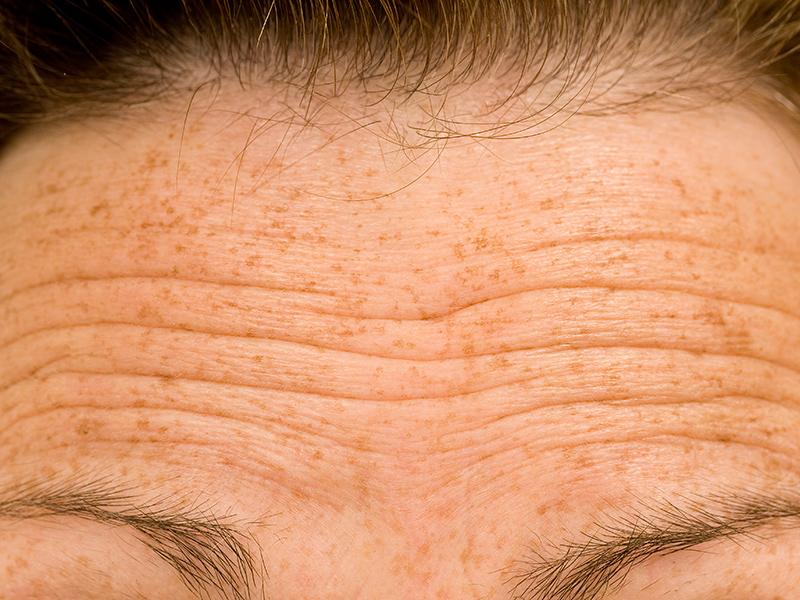
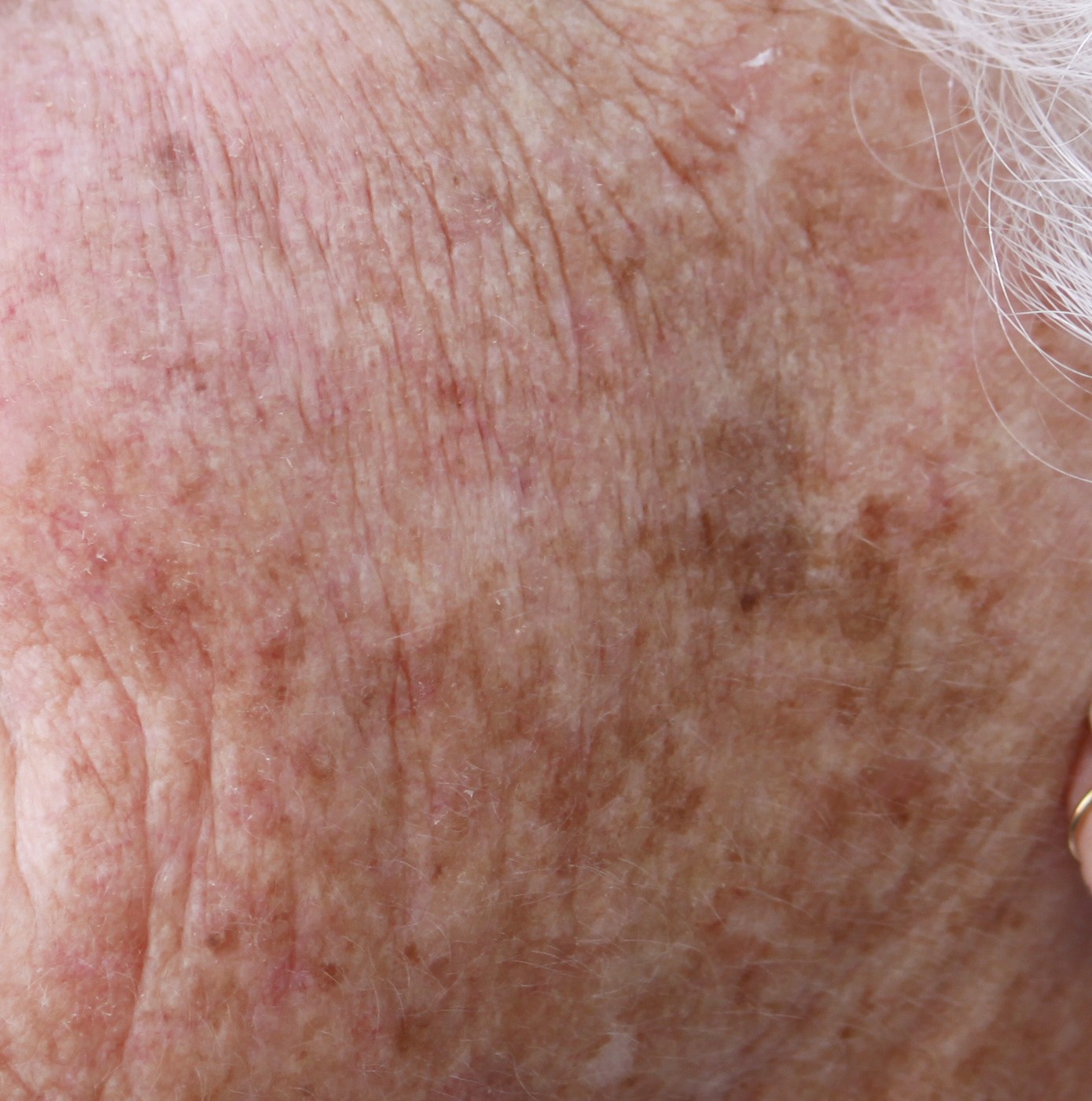
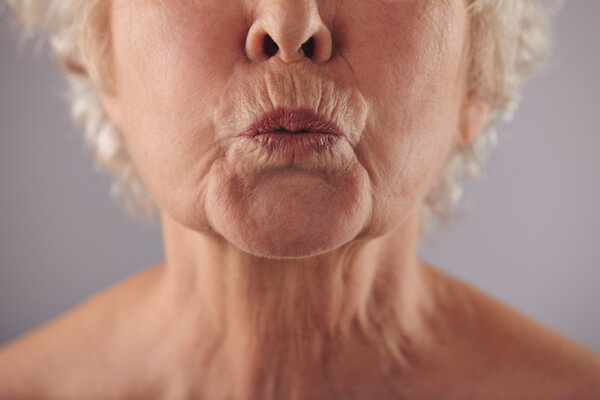
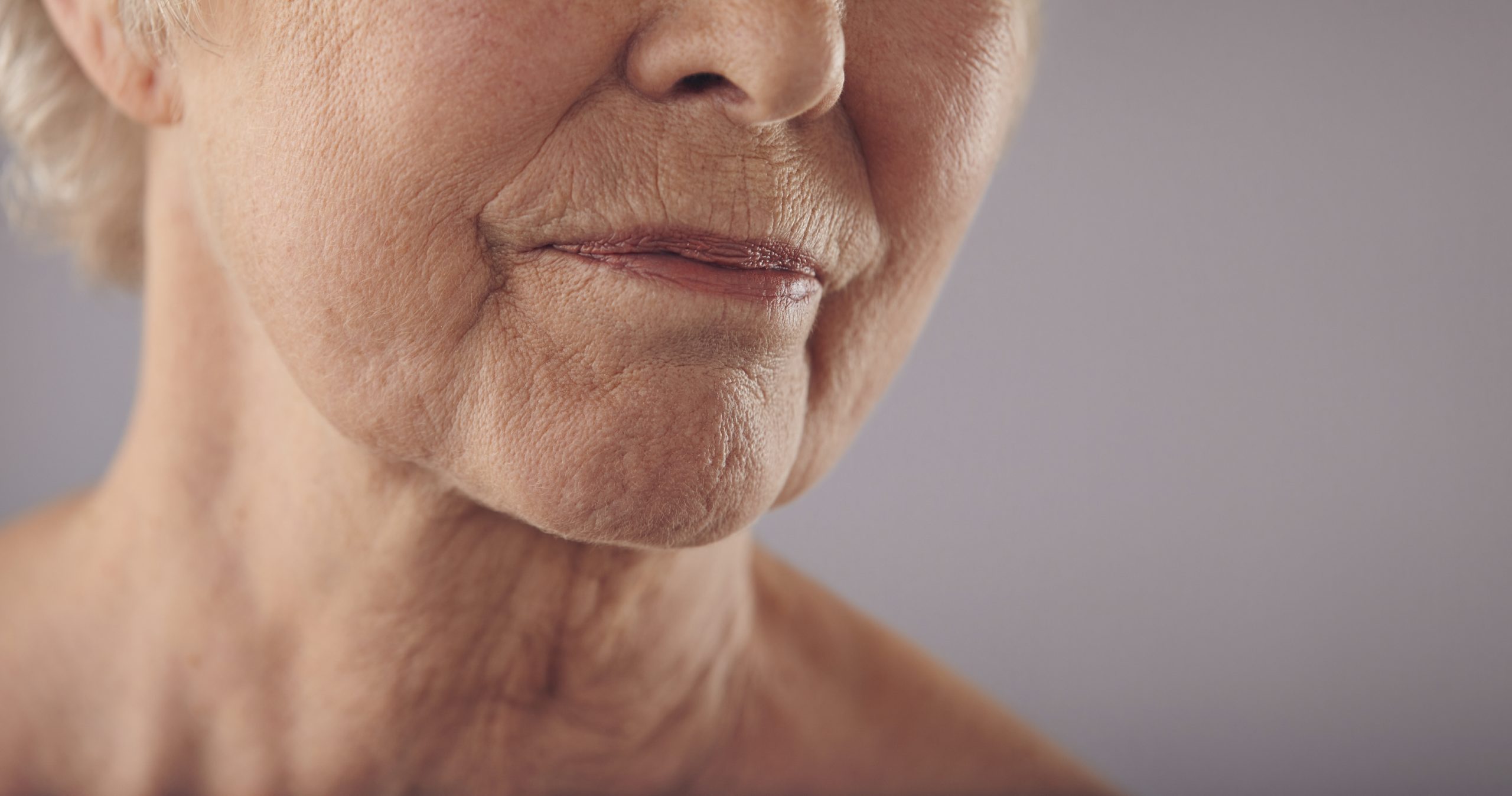
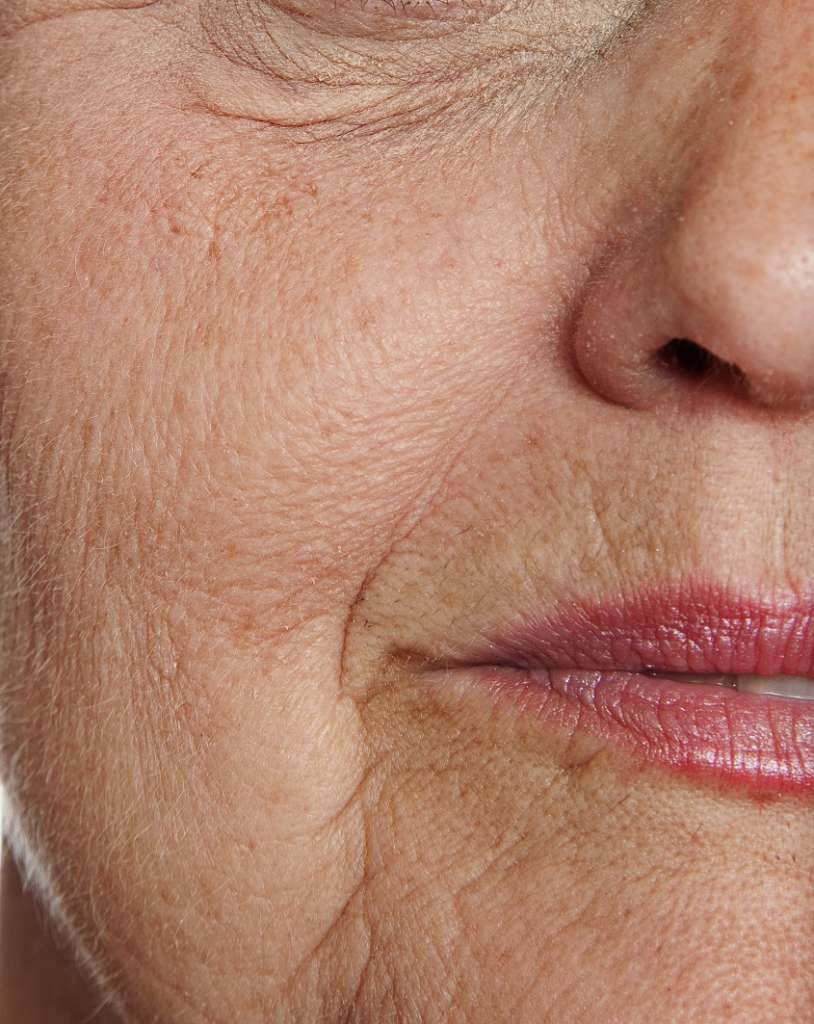
WHY TREAT SKING AGING?
Seeking out the best appearance one may attain is common to the treatment of many skin diseases including such “medical” diseases as acne and psoriasis, where it is well-documented that treatment improves ones self-esteem and quality of life. We all strive to stave off the loss of our physical and mental abilities as we age, as well.
HOW CAN I TREAT AGING SKIN?
The treatment of aging changes of the face is diverse. Topical treatments consist of vitamin A derivatives, alpha hydroxy acids, vitamin C preparations, plant and botanical derivatives, antioxidants, growth factors and peptides. There are numerous types of chemical peels and microdermabrasions. Laser surgery and radiofrequency devices can be used to correct “sun freckles”, dilated blood vessels and wrinkles. BOTOX Cosmetic®, collagen, hyaluronic acid and fat injections can help with certain lines of expression and loss of facial fullness. More major surgical procedures include laser resurfacing.
TOPICAL TREATMENTS FOR AGING SKIN
Vitamin A Derivatives (retinoids)- tretinoin (Retin-A, Renova),tazarotene (Tazorac,Avage), and adapalene (Differin) and various types of retinols. Of all the topical agents, prescription retinoid creams have the most scientific evidence demonstrating they can reverse aging changes. Tretinoin has been shown to reduce fine lines, mottled hyperpigmentation (age and liver spots), and sun damage. The main problem with tretinoin and the other retinoids is that many people cannot tolerate the side effects of dryness and irritation that often accompany their use. There is sometimes a period of “retinization” that can last as long as two weeks that causes skin redness, peeling and discomfort. This is one of the reasons retinol creams have become popular – they are not as drying as Retin-A. Although the effects of retinol creams on human skin have been studied far less than that of the Rx retinoids, they hold great promise. A recent study shows that retinol does increase collagen in human skin. Vitamin A derivatives retinoids or retinols) are the cornerstone of any topical antiaging regimen, although people with rosacea and/or sensitive skin would be advised to avoid them as they tend to aggravate the condition by stimulating blood vessel growth.
Alpha hydroxy and polyhydroxy acids (AHAs) – glycolic acid, lactic acid, gluconolactone
In the early 1970’s the team of Van Scott and Yu discovered that alpha-hydroxy acids could dramatically improve severely dry skin. In the late 1980’s they formed a company called Neostrata, making them the first to develop and manufacture alpha-hydroxy acid “cosmeceutical” creams. The great thing about alpha and poly hydroxy acids is that they are inherently moisturizing. Since people with aging skin often have dry skin, it is an excellent choice. The alpha hydroxy acids (glycolic acid and lactic acid- derived from fruit acid and milk, respectively), confer a lot of benefits including smoother, softer skin, a pink “glow” and more even pigmentation. Their application results in an increase in collagen deposition, improved quality of elastic fibers and thickening of the epidermis (the layer of the skin that retains water and acts as a barrier to environmental insults). It is important to know what strength of free acid is present in the preparation one is using, because the higher the strength, the greater the benefits. Many creams that sport a high percentage on their label have been “neutralized’- that is, partially inactivated by a “base” to make the acid have less of a stinging feeling. This decreases the effective free acid percentage, and thus, their effectiveness at producing the desired results, although they are frequently more tolerable.
Furfuryladenine (Kinerase)
Kinerase is a plant extract shown to delay the aging process in plants, fruitflies and human fibroblast cells (cells that make collagen). It may also act as a free radical scavenger, meaning that it has antioxidant properties and can protect cells from toxic insults. Its main advantage is that it is non-irritating. Many people cannot tolerate either the drying of the vitamin A derivatives or the stinging induced by the alpha hydroxy acids. For people with sensitive skin, Kinerase is a good choice. The jury, however, is still out regarding its effectiveness – no peer reviewed journal (articles accepted by an independent panel of experts in the subject chosen) has yet published a study. A preliminary study from the University of California Irvine has shown it to be effective in reducing fine wrinkles, coarse texture and blotchy pigment after 24 weeks of twice a day use. It represent a good choice for people with very sensitive skin and/or rosacea.
Vitamin C
Vitamin C is an antioxidant which sops up the toxic molecules that occur in skin cells when they are exposed to ultraviolet light. It has been shown to reduce skin damage from ultraviolet light in animals. It is very difficult to get a Vitamin C preparation adequately absorbed into the skin due to its low pH and other molecular factors and it is also unstable in solution, as the vitamin becomes easily inactivated when it is exposed to air or light. Different manufacturers of vitamin C products have made claims that their product has the special formula that makes it absorb into the skin and not lose potency. Although there is one published study showing that topical vitamin C reverses aging changes in humans, their is more evidence it will help to prevent (as opposed to reverse) aging changes, especially due to ultraviolet light induced damage .
Beta-hydroxy acids
Beta-hydroxy acid really is salicylic acid, an ages-old medicament used for various conditions which some contend isn’t really a “beta-hydroxy”, but it took on this popularized name after alpha-hydroxy acids came into vogue. Salicylic acid is used in many different types of medications and is related to aspirin (which is acetylsalicylic acid). It is used in antiaging products as a 1-2% concentration and can also smooth fine lines, improve surface texture and tone, in similar fashion to the alpha-hydroxy products. But salicylic acid also helps to clear pores, thus making it superior in this regard for the treatment of acne and coarse skin pores. Superficial peels with 20-30% beta-hydroxy (known as B-lift peels) can be effective if done repetitively to improve the surface of aged skin and fine lines, irregular pigment and even acne scars. (See more information below in the section on superficial chemical peels).
INTERMEDIATE TREATMENTS OF AGING SKIN
Chemical Peels
Chemical peels involve the application of a liquid, gel or mask to the surface of the affected area (face, chest, neck, etc.) with the intention of lifting off some portion of the skin. The chemical is usually an acid that essentially “burns” the skin in a controlled fashion to a certain depth and then either stops or is neutralized. Afterwards, the layers of skin are sloughed off and new skin is formed. There are two important variables in chemical peeling- the strength or concentration of the solution and which chemical is chosen. • Superficial chemical peels Very superficial chemical peels are popular right now because there is little to no “down-time” which is why they are sometimes referred to as “lunchtime peels”. One can have these performed and go back to ones daily activities looking a little flushed: minimal peeling such as what you would get after a mild sunburn might ensue. These are done at regular intervals and are used to “jump-start” the effects of topical antiaging preparations. Very superficial chemical peels mainly remove the “dead” layer of skin (stratum corneum), but this appears to send a signal to the deeper layers of the skin to make new collagen. Very superficial chemical peels would include 20-30% salicylic acid (B-Lift peel), alpha hydroxy 20-30% glycolic acid peels (neutralized at the right time). Superficial chemical peels would include 15%-20 TCA (trichloroacetic acid) or the 11% TCA mask (Accupeel), and Jessner’s solution. These may include a few days of peeling and sloughing skin. Finally, similar effects and aftercare could be expected from light (very superficial) or medium (superficial) microdermabrasion. Another advantage of the very superficial peels is that they can be used safely on people with darker skin tones, whereas higher strength peels can cause hyperpigmentation (excess pigment) in the healing stages.
Microdermabrasion
This is a machine that looks like a small vacuum cleaner that has a hand piece on it with suction which is put against the face or affected area. The suction then lifts up the skin and bombards it with tiny aluminum oxide crystals that lightly abrade the surface in a very uniform way. The depth of penetration can be increased by changing the pressure in the machine or the number of times the skin is passed over. Thus, one can get a deep abrasion, similar to a dermabrasion if used this way, with similar profound changes in the skin. The aftercare is usually a bland moisturizer and one typically has a slightly sunburned appearance with mild peeling for a few days. These offer similar results to a series of superficial chemical peels.
Botox.
Originally used and approved by the FDA for blepharospasm and strabismus (abnormalities in eye muscles), injectable botulinum toxin was “discovered” by Dr. Jean Carruthers, a Canadian ophthalmologist who noticed it was improving the wrinkles around the eyes in her patients. She and her husband Alastair, a dermatologist, went on to explore its uses and the Botox phenomenon of was born. It is the number one cosmetic treatment worldwide. The main uses for Botox cosmetic are for the frown lines between the brow, on the forehead and the wrinkles around the eyes. Botox is made up of botulinum toxin, one of the most potent poisons known to mankind. Its principal action is to paralyze muscle. When used in small dilutions in a controlled fashion by a skilled physician with extensive knowledge of the anatomy of the face, it has a surprisingly good safety record. Many of the larger wrinkles on the face are really “lines of expression”. This means that they are creases formed by the repetitive movement of characteristic facial expressions. When a person frowns a certain way and after many years and many frowns the skin forms a crease where it was repeatedly bent as a result of the muscular action. The amazing thing about botox is that when you relax the muscles involved, you can actually make the crease go partially or completely away. The main side effect of Botox is too much muscle relaxation in muscles that were not targeted, leading to eyelid or brow drooping. This is caused by an injection that is too close to the muscle that lifts up the eyelid or the solution diffuses to that area, hence paralyzing its function. Occasionally people get headaches (although ironically using Botox has become a new and very effective treatment for headaches ). Some people don’t like the fact that they can’t frown as it limits their facial expressivity. However, with skilled injections, facial expressivity is maintained. Botox is also being used for hyperhidrosis (it has recently been approved for this use by the FDA), a condition of excess sweating of the hands, axillae (underarms) or feet. The main limiting feature of Botox is that its effects are temporary. While this may be a good thing if you have a side effect, it becomes quite an expense to have to get it repeated every 3-4 months, at somewhere in the range of $3-800 per treatment. Some people have found that after repeated injections they don’t make the involuntary expressions leading to the crease, resulting in a kind of “biofeedback” on the muscles so that Botox is not needed as frequently to maintain the effect.
Injectable Fillers: Collagen (Zyderm, Zyplast) and Hyaluronic Acid (Restylane Fine Lines, Restylane, Perlane, Hyalaform, Hyalaform Plus)
Injectable fillers are materials made from collagen or hyaluronic acid that are injected into wrinkles to erase them. It is a very effective treatment and also affords instant gratification, in that the results are immediate. Like botox, the effects are temporary because eventually the body metabolizes and reabsorbs the material. Collagen and Hyalaform injections need to be repeated every 3-6 months for maintenance and it appears that Restylane lasts more like 6-9 months, depending on the area. The advent of Restylane has caused a lot of excitement in the aesthetic arena. It has considerably more volume replacement properties than other fillers, allowing skilled practitioners to be able to artistically sculpt the face. One of the most common areas it is used is the nasolabial folds and in the wrinkles around the mouth. The biggest problem with collagen is that it causes allergic reactions in a small percentage of people. It is very important to undergo collagen skin testing twice. The first test area is observed for an entire month, because the allergy can be delayed for some time. Then a second test is performed because there is a small fraction of people who become allergic to it upon re-exposure. These two tests screen out more than 99% of people who would be allergic. Another concern with collagen that surfaced around the same time as the breast implant scare was whether or not it could cause collagen vascular diseases (arthritis and/or autoimmune types of diseases). Although this has never been born out in any medical studies, it still is recommended to avoid collagen injections if there is a personal history of lupus, rheumatoid arthritis or scleroderma. However, many thousands of people have had these injections for over 20 years and collagen has an excellent safety record.
Kybella
Injectable treatments that help improve the appearance and profile of moderate to severe fat below the chin (submental fat or the “double chin”). Kybella destroys fat cells, resulting in a noticeable reduction in fullness under the chin. Reducing a “double chin” can lessen the perception of aging in other skin regions.
Laser Resurfacing
In the mid-1990’s a revolution took place in aesthetic surgery with the advent of the high-intensity pulsed carbon dioxide laser . These machines were capable of delivering a predictable depth of penetration into the skin, so that one could almost “sculpt” away wrinkles and scars. In addition, studies showed that there was “collagen shrinkage”, which meant that for the first time one might be able to actually tighten the face, or reverse some of the sagging which heretofore had only been able to be accomplished via face-lifts. After a period of time it became apparent that this procedure had considerable risks as well. Many of the risks were actually quite similar to medium and deep chemical peels and could be predicted by the depth of the tissue wounding. These include prolonged redness, often lasting up to 6 months after the procedure , hyperpigmentation (blotchy dark discoloration) which also resolved with treatment and time, and most disconcerting, a white appearance that occurs many months after the procedure and appears to be irreversible in a small percentage of those treated . The introduction of the erbium YAG laser was heralded as the end of the complications of laser resurfacing . This laser is more purely “ablative” meaning that it vaporizes the tissue but doesn’t heat it. Many researchers had related the long course of redness and other complications to the “zone of thermal necrosis”, that is, a depth of heating that didn’t occur with the erbium laser. Also, it appeared to be safer on darker skin types as well as requiring less anesthesia. When they are used for the appropriate reasons and their limitations are recognized, the person undergoing the procedure understands the risks fully and postoperative care is maximized , these are excellent treatments for moderate to severe aging of the face.
Other laser procedures
The newest laser procedures involve trying to rejuvenate the skin without actually removing or burning the top layer, sometimes called subsurface or noninvasive resurfacing. One procedure involves another wavelength of YAG laser at 1320 NM (Cool Touch) which heats up the upper layer of skin causing a remodeling process. The other employs an intense pulsed light source (Photoderm, Multilight or Vasculight) to focus heat on dilated blood vessels in the upper layer of skin and achieve the same remodeling and production of new skin . Both of these procedures require multiple treatments but one can return to one’s activities immediately and they have very low risk. The procedure utilizing an intense pulsed light source is called photorejuvenation. Photorejuvenation procedure works especially well on sun damaged skin with many dilated blood vessels and sun freckles. This is a relatively new procedure and I have been extremely pleased with the results in my patients thus far.
SCHEDULE AN APPOINTMENT TODAY
ADDRESS
711 E Lamar Blvd # 200
Arlington, TX 76011
moreinfo@acderm.com
PHONE
817-795-SKIN (7546)
HOURS
Mon – Thur | 7:00 AM – 4:00 PM
Fri | 07:00 AM – 12:00 PM
Closed on Weekends
GO WITH CONFIDENCE
Where did this information come from?
Lober CW, Fenske NA. Photoaging and the skin: differentiation and clinical response. Geriatrics 1990 Apr;45(4):36-40,42.
Kligman LH.Photoaging. Manifestations, prevention, and treatment. Dermatol Clin 1986 Jul;4(3):517-28.
Kadunce DP, Burr R, Gress R, Kanner R, Lyon JL, Zone JJ. Cigarette smoking: risk factor for premature facial wrinkling. Ann Intern Med 1991 May 15;114(10):840-4.
Antell DE. Ann Plast Surg 1999;43;585-588.
Emerit I. Free radicals and aging of the skin. EXS 1992;62:328-41.
Weiss JS, Ellis CN, Headington JT, Tincoff T, Hamilton TA, Voorhees J. Topical tretinoin improves photoaged skin. A double-blind vehicle-controlled study. JAMA 1988 Jan22-29;259(4):527-32).
Fluhr JW, Vienne MP, Lauze C, Dupuy P, Gehring W, Gloor M. Tolerance profile of retinol, retinaldehyde and retinoic acid under maximized and long-term clinical conditions. Dermatology 1999;199 Suppl 1:57-60.
Varani J, Warner RL, Gharaee-Kermani M, Phan SH, Kang S, Shung J, Wang Z, Datta SC, Fisher GJ, Voorhees JJ. Vitamin A antagonizes decreased cell growth and elevated collagen-degrading matrix metalloprotreinases and stimulates collagen accumulation in naturally aged human skin. J Invest Dermatol 2000 Mar;114(3) :480-486.
Van Scott EJ, Yu RJ. Control of keratinization with alpha-hydroxy acids and related compounds. Arch Dermotl 110:586-590,1974.
Stiller MJ, Bartolone J, Stern R, Smith S, Kollias N, Gillies R, Drake LA. Topical 8% glycolic acid and 8% L-lactic acid creams for the treatment of photodamaged skin. Arch Dermatol 1996 Jun;132(6):631-6.
Ditre CM, Griffin TD, Murphy GF, Sueki H, Telegan B, Johnson WC, Yu RJ, Van Scott EJ. Effects of alpha-hydroxy acids on photoaged skin: a pilot clinical, histologic, and ultrastructural study. J Am Acad Dermatol 1996 Feb;34(2 Pt 1):187-95.
How to deliver good glycolic acid therapy. Dermatology Times, Jan. 1997.
Ruey JY, Van Scott EJ. Bioavailability of alpha-hydroxy acids in topical formulations. Cosmetic Dermatology Vol. 9 No. 6, June 1966.
Sharma SP, Kaur P, Rattan SI. Plant growth hormone kinetin delays aging, prolongs the lifespan and slows down development of the fruitfly Zaprionus paravittiger. Biochem Biophys Res Commun 1995 Nov 22;216(3):1067-71.
Rattan SI, Clark BF. Kintein delays the onset of aging characteristics in human fibroblasts. Biochem Biophys Res Commun 1994 Jun 15;201(2):665-72.
Barciszewski J, Siboska GE, Pedersen BO, Clark BF, Rattan SI. A mechanism for the in vivo formation of N6-furfuryladenine, kinetin, as a secondary oxidative damage product of DNA. FEBS Lett 1997 Sep 8;414(2):457-60.
McCullough, Jerry. Furfuryladenine-A new antiaging topical: research and clinical experience. Skin and Allergy News supplement, Highlights from a symposium at the 23rd Annual Hawaii Dermatology Seminar, 1999, pps.-3-5.
Coven RM, Pinnell SR. Topical Vitamin C in aging. Clin Dermatol 1996 Mar-Apr;14(2):227-34.
BissettDL, Chatterjee R, Hannon DP. Photoprotective effect of superoxide-scavenging antioxidants against ultraviolet radiation-induced chronic skin damage in the hairless mouse. Photodermatol Photoimmunol Photomed 1990 Apr;7(2);56-62.
Traikovich SS. Use of topical ascorbic acid and its effects on photodamaged skin topography. Arch Otolaryngol Head Neck Surg 1999 Oct;125(10):1091-8.
Darr D, Dunston S, Faust H, Pinnell S. Effectiveness of antioxidants (vitamins C and E) with and without sunscreens as topical photoprotectants. Acta Derm Venereol 1996 Jul;76(4):264-8.
A comparative Evaluation of a novel low-strength salicylic acid cream and glycolic acid products on human skin. Kligman AM, Supplement to Cosmetic Dermatology, Sept., 1977, Pps. 11-15.
Kligman D, Kligman AM. Salicylic acid peels for the treatment of photoaging. Dermatol Sur 1998 Mar;24(3):325-8.
Ragland HP, Mc Burney E. Complications of resurfacing. Semin Cutan Med Surg 1996 Sep;15(3):200-7.
Pinski,JB. TCA Mask: A new form for an old standard. Highlights from a symposium at: The 23rd Annual Hawaii Dermatology Seminar. Skin and Allergy News, 1999, pps 7-8.
Matarasso SL, Glogau RG. Chemical face peels. Dermatol Clin 1991 Jan;9(1):131-50.
Moy LS, Kotler S, Lesser T. The histological evaluation of pulsed carbon dioxide laser resurfacing versus phenol chemical peels in vivo. Dermatol Surg 1999 Aug;(8):597-600.
Histology confirms power of particle resurfacing. Bates, Betsy. Skin and Allergy News, Nov. 1999, Pps. 1-3.
Carruthers JD. Ophthalmologic use of botulinum A exotoxin. Can J Ophthalmol 1985 Jun;20(4):135-41.
Carruthers JD, Carruthers JA. Treatment of glabellare frown lines with botulinum A exotoxin. J dermatol Surg Oncol 1992 Jan;18(1):17-21.
Klein AW, Glogau RG. Botulinum toxin: beyond cosmesis. Arch Dermatol 2000, Vol. 136, 539-541.
Silberstein S, Mathew N, Saper J, Jenkins S. Botulinum toxin type A as a migraine preventative treatment. Headache 2000 Jun 24;40(6):445-450.
Solomon BA, Hayman R. Botulinum toxin type A therapy for palmar and digital hyperhidrosis. J Am Acad Dermatol 2000 Jun;42(6): 1026-1029.
Klein, Arnold. Comments during presentation of Tissue Augmentation symposium, American Academy of Dermatology 58th Annual Meeting March 10-15,2000.
Watson W, Kaye RL, Klein A et al. Injectable collagen: a clinical overview. Cutis 1983 May;31(5):543-6.
Alster T, West T. New options for soft tissue augmentation. Skin and Aging, July 1998, Pps. 32-36.
Coleman WP 3rd. Fat transplantation. Dermatol Clin 1999 Oct;17(4):891-8, viii.
Gormley DE, Eremia S. Quantitative assessment of augmentation therapy, J Dermatol Surg Oncol 1990 Dec;16(12):1147-51.
Fitzpatrick RE, Goldman MP, Satur NM, Tope WD. Pulsed carbon dioxide laser resurfacing of photo-aged facial skin. Arch Dermatol 1996 Apr;132(4):395-402.
Trelles MA, Mordon S, Svaasand LO et al. The origin and role of erythema after carbon dioxide laser resurfacing. A clinical and histological study. Dermatol Surg 1998 Jan;24(1):25-9.
Manuskiatti W, Fitzpatrick RE, Goldman MP. Long-term effectiveness and side effects of carbon dioxide laser resurfacing for photoaged facial skin. J AM Acad Dermatol 1999 Mar;40(3):401-11.
Khatri KA, Ross V, Grevelink JM et al. Comparison of erbium:YAG and carbon dioxide lasers in resurfacing of facial rhytides. Arch Dermatol 1999 Apr;135(4):391-7.
Zachary CB. Modulating the Er:YAG laser. Lasers Surg Med 2000;26(2):223-6.
Weinstein C, Ramirez O, Pozner J. Postoperative care following carbon dioxide laser resurfacing. Avoiding pitfalls. Dermatol Surg 1998 Jan;24(1):51-6.
Goldberg DJ, Cutler KB. Nonablative treatment of rhytids with intense pulsed light. Lasers Surg Med 2000;26(2):196-200.
Goldsmith LA. A message from the future. Arch Dermatol 2000, 136(1), 46-7.







